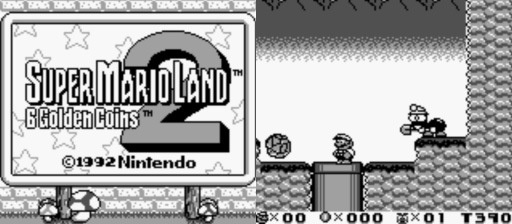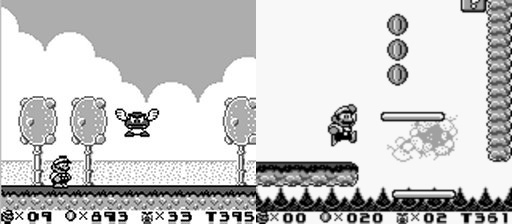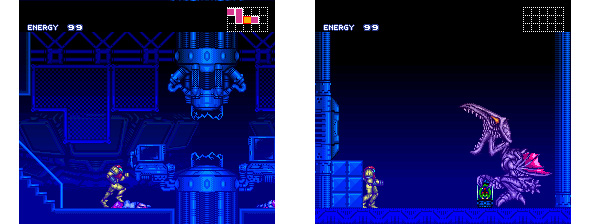Super Metroid – The Tenets of a Metroid Game
August 9th, 2010
The Tenets of a Metroid Game
Although Metroid can be categorized as a platforming shooter within a space-themed context, the franchise isn’t so much about the shooting or the jumping at all. Rather, Metroid is all about that misplaced bit of space rock. You know, the one with a little bit of extra fungus. The one that, after met with a morph ball bomb, will string you down a tiny alley to a small chamber containing the next power-up. Progression in Metroid hinges on the abilities granted by various power-ups which are connected to a string of environmental puzzles. It’s in the player’s ability to realize these puzzles through acute observation and then use their ability set to act upon their observations that Metroid reveals its true colors as a game of deep observation and multi-faceted problem solving. Metroid has always relished in being more than what it presents itself as, and series fans appreciate the franchise for valuing the deep implicit over the loud and overt. There’s a maturity in the series which has gone untarnished even as the franchise has evolved from two to three dimensions.
Metroid is also an innovator, but rarely proclaims its achievements on the back of the box. The Metroid games have not just defined but also realized a style of video game narrative that intertwines story with landscape. Oftentimes in a Metroid game, you’ll find yourself entering a world where events have long passed, and as the player you piece together story through the visual, audio and interactive pieces of the landscape (in the Metroid Prime sub-series text is also included). Through it’s environment Metroid builds a civilization and tasks the player as a defacto cultural architect. In this regard, many of the environmental puzzles, particularly those which require the use of machinery or are constituted with cultural relics, act as demonstrations of civil processes. Rarely do video games build lore this rich, or yet, so seamlessly into the fabric of the gameplay. Metroid is a narrative of few words, but with depth that many strive for.
Tense atmosphere and the sense of isolation felt by the player are also tenets of the Metroid franchise. In Super Metroid, the title screen with the baby metroid in the jar establishes an almost complete absence of life. Again, the setting, but, more correctly, the sound is used as a device to control mood. Where many other games opt for busy noise, Metroid instead opts for controlled instances of silence followed up crescendos which build and create tensions. Moments where little happens, but much is felt.
Since the atmosphere, narrative and overall framework for exploration are harmoniously built into the environment and therefore the gameplay, Metroid is a franchise that stands as a testament to good game design. As Metroid‘s design is very medium-centric, relying on the factors that define video games (interactivity, adaptive environments), the franchise excels at conveying atmosphere, narrative and challenge to the player.
More obvious to mainstream video games folk is the fact that Metroid, through protagonist Samus Aran, champions femininity without sexualization or even glorification of the empowerment of women. Metroid, particularly Super Metroid – the title in question – has been a standout title for speed running, the art of completing a game in the shortest time possible. Overall then, Metroid is an eminent video game series, a series which fosters exploration, harmonious narrative and gameplay, atmosphere, works against the grain of video game gender stereotypes, yet facilitates dedicated game communities through speed running. And for all this, in the sense of the games themselves, Metroid is modest about its achievements which makes it all the more a champion.
Overseas Gaming Journal: Survival Guide
August 9th, 2010
When living overseas, we often have to make concessions for the comfort activities we enjoyed when at home. Maintaining our interest and hobbies is a way for us to re-connect with an identity that can sometimes feel suffocated by the new environment and its surrounding culture. Currently, I’m working abroad in China, so for me, playing video games is a way for me to temporarily relieve myself of my predetermined role as an outsider, a foreigner. Video games, as with long distance phone calls and family photos, are comfort food for the soul, and that’s pretty important. Maintaining a hobby like video games abroad is rather tricky though, so I’ve written a list of suggestions that may help others in their relocation overseas.
Bring a Portable Console
A no-brainer, huh? Personally, I chose to bring my original DS along since it can play both DS and GBA games and I have games on both console to complete. The carts are quite small, so the DS is a relatively low fuss option if you’re willing to drag the media itself overseas. I didn’t invest in a carry case for my gear (I play portable games at home), so snap-lock Glad bags have proven sufficient for storying my cartridges. The DSi has an online store for downloadable DSiWare games, so there’s incentive to bring the newer model overseas, if you’re not interested in GBA functionality. Whether the online store still works overseas I can’t say, so it may be a good idea to stock up on games prior to leaving.
The PSP is another option, but one which can be less favourable if you’re less willing to bust the firmware. The UMD discs are a tricky to cart around in comparison to the DS game cards and the open-faced system isn’t exactly portable-friendly. Fortunately, the PSP does allow you to install games onto the device, but with PSP games ranging from 500mbs to 1.6gb in size, the option isn’t so ideal for storing multiple games.
The PSPgo, on the other hand, is an ideal solution with its 16gb harddrive. Topped with PSN classics and PSP Minis and you’ve got yourself a handy travel companion without the need for excess baggage. There’s also travel software like the Passport to [Europe] series and Talkman [Asian and Europe].
In an email, Sony Australia believe that the Playstation Store should be accessible while in China (and thereby most countries), so long as there is no interference from the web filter (a VPN is an easy solution for the latter). I personally would recommend modding your PSP for back ups. However, tread carefully as modable PSP models are no longer in production and the majority of new PSPs floating around on eBay only support temporary modification in the flash memory which is extremely fiddly.
Your iPod/iPhone doubles as a Portable Games Console
The iPod is probably the most user-friendly device for playing games overseas. It’s ultra portable, games are cheap, but above all else, you can access any of the iTunes stores from any country in the world. If you already own an iPod or iPhone and have iTunes and a computer/a wireless connection for internet access, then there’s little reason for your life overseas to hinder your mobile gaming.
Laptop, rip isos, use steam, plain installs, patches
Like the iPod/iPhone, a laptop, even an older laptop, is a great way to stay in tune with gaming. My Macbook has a Windows XP partition which houses my Steam collection, games installed completely to the harddrive, isos of games which won’t run without the CD/DVD, games patched to run without a CD/DVD in the drive, files from Good Old Games, some emulators and games (my Amiga 500 video outputs are busted) and a hoist of indie games. All in all, I have roughly 30-40 games on my Windows partition, enough to last any one a long time.
For Steam, I recommend downloading your games at home and then setting the service to ‘offline mode’ just in case anyone at home decides to boot up Steam and you’re account is suspend etc.
Web Games
Maybe you haven’t considered it, but there are literally bazillions of online games which can be enjoyed at home or in an internet cafe. NewGrounds and Kongregate are great sites for free flash games. Given everything else I’ve set up over here, I don’t often play browser-based games, but that’s by no means an assertion that they’re not worth your investment.
VPN
Since I’m living in China I’ve decided to secure my connection and avoid the internet filter by purchasing a year long membership to a virtual private network service. Depending on the country you’re living in, content may be filtered by the government and a popular target for internet filtering are games websites. Not just news and information websites like Kombo, but Flash game websites, websites for independent developers and general downloading sites which offer video game content.
Accept the Indie Scene
When I am away from the home consoles I like to veg out on indie games, because they’re just so worth your time. Here’s a couple of links to get you started.
Conclusion
On my side of the fence, being away from home offers up the opportunity to try out games which might otherwise be forgotten when at home, and there’s something very rewarding about that. I’m not a big PC gamer and I’m not as invested in the indie scene as I’d like to be, so living abroad allows me to remedy these issue, and along with the comfort food games provide, there’s really no sacrifice to my gaming diet.
R&D1: Deconstructing the Mario franchise on the Game Boy
August 1st, 2010
Portable game development has always acted as a test bed for experimental ideas. The handheld platforms are inexpensive to develop for and widely regarded as second-tier products to their console counterparts, making them the ideal haven for experimentation. Knowing this, R&D1, a technically-minded internal studio at Nintendo (now absorbed into Nintendo Software Planning & Development), used the newly released Game Boy as a way to expand the company’s most famous property: Mario. The design sensibilities and the innovations which evolved from the early Game Boy games Super Mario Land and Super Mario Land 2: 6 Golden Coins would find themselves not only canonized into franchise lore, but also playing a wide-reaching role in further developments of the series.
Super Mario Land
Prior to, and even since Super Mario Land‘s release in 1990, no other Mario title has modeled itself on real world cultures. Perhaps in a move to justify the “land” part of its title, Super Mario Landwas no longer set in the Mushroom Kingdom, but Sarasaland. Sarasaland was divided into 4 parts: an Egyptian-themed environment, an alien water world, ancient Aztec ruins and a Japanese oriental garden whose final act was set amongst the clouds. This was Super Mario Land‘s core conceit, and although no game in the series has since replicated world culture, Super Mario Landpaved the way for environments far removed from the realm and influence of the Mushroom Kingdom. Chocolate Island in Super Mario World, Yoshi’s Island in Super Mario World 2 and Isle Delfino in Super Mario Sunshine are good examples.
In relocating Mario outside of his stomping ground, R&D1 also replaced franchise staples: Bowser with Tatanga, Princess Peach with Princess Daisy and all familiar enemies – minus goombas – for stage-specific variants. Super Mario Land drove momentum for new and diverse enemies sets which could, at least for their respective titles, take a prominent role in the main cast. Princess Daisy has since been recognized in series cannon, playing a recurring role in the Mario sports andMario Kart series.
Not only did Super Mario Land go global and shed the Mushroom Kingdom attire, but the items and mechanics which remained were subversively tweaked and altered. Fireballs could now bounce off walls and surfaces, collecting coins in its wake. This lead to some cleverly designed puzzles as coins were often placed outside of Mario’s physical grasp. The end of level bonus was also reworked so that instead of being rewarded with a 1UP upon landing on top of a flagpole, players would have to navigate tricky platforms to reach a second floor which would prompt a small mini-game granting power-ups. The princess was still in another castle, however this time she was a facade whom would transform into one of Tatanga’s minions; one of the more obvious acts of tomfoolery. Further still, R&D1 undermined players with the koopa-esque bomb turtles who would detonate shortly after jumped upon. Nabbing a mushroom in mid-air would no longer cut Mario’s forward momentum. Not all of these tricks were intentional though, because of the Gameboy’s monotone graphics and Super Mario Land‘s tiny sprites, 1UP mushrooms were changed into hearts so that they could be easily discerned from power-ups. By tinkering with the player’s prior understanding of series norms, even minutely as some of the examples prove, Super Mario Land acknowledged a form of general trickery, and humor for long-time players which has permeated through most iterations of the series. Wriggler and Mecha-Bowsers in Super Mario World, Flower-head Shy Guys in Yoshi’s Island are further examples.
Totally new to Super Mario Land are the shoot-’em-up inspired levels where Mario mans a submarine (marine pop) or a plane (sky pop) to shoot down his enemies. The submarine level replaces the usual under water, swimming levels which are absent in this iteration. Even though these sections are tangential to the platforming, you can see elements of this design in Super Mario Sunshine and Super Mario Galaxy where other gameplay modes, such as pull stars, 2D gravity switching and manta ray surfing sequences are interspersed with the platforming.
Perhaps, above everything else though, Super Mario Land established portable design sensibilities.Super Mario Land wasn’t merely Mario on a portable console; it was a game designed for dedicated play in front of a TV adapted to the needs of playing on the go. This sense for quick, short bursts of play has been pivotal to many of Nintendo design sensibilities both in the console and handheld space. The star system in the 3D Mario games are examples of portability-minded design on a console, the “turning the machine on everyday” design of the Wii is another such example.
Super Mario Land 2: 6 Golden Coins
Super Mario Land 2 isn’t as radical as its predecessor, but it’s still pretty far removed. This time Mushroom Kingdom environments are mixed with properties of suburban reality. In many ways,Super Mario Land 2: 6 Golden Coins is reminiscent of the 1989 movie Honey, I Shrunk the Kids.Super Mario Land 2 is a slower-paced, exploratory platformer, so all of the sprites are enlarged which makes the world feel large and expansive. The overwhelming nature of the world works in combination with the assembly as household pests which populate the world alongside goombas and koopa troopas. This ordinary form of reality is revisited somewhat in Isle Delfino in Super Mario Sunshine and the Princess’ castle in Super Mario 64.
Two of the themed worlds deserve particular mention though. The first is the moon stage which would arguably foreshadow the release of Super Mario Galaxy. The second is the bizarre toy Mario level. An obvious piece of self-reference in the series at the time, later preceded by Special in Super Mario World. This type of irreverent self-reference would become a common theme throughout most of Nintendo’s games. It’s worth adding that Super Mario Galaxy (Toy Time Galaxy) also features a mechanical toy as one of its planets, taking liberally from Super Mario Land 2.

Super Mario Land 2‘s greatest work of subversion comes with the introduction of anti-hero Wario. Labeled as a temper tantrum tyrant, Wario was jealous of Mario’s position as a Mushroom Kingdom socialite and literally dethroned him from his castle. Wario spun out his own sub-series of games and gave a sense of character, sophistication and self-deprecating humor to the villains of the Mario universe. Waluigi, Fawful and even the toads in Super Mario Galaxy are additional examples.
In contrast to Super Mario Land, which utilized the original Super Mario Bros. as its design template, Super Mario Land 2 is a hybrid of Super Mario Bros 3 and Super Mario World‘s overworld. Levels may be connected via a hub world, but structurally 6 Golden Coins is completely open. On completing the initial tutorial stage, the player is free to tackle any of the 6 worlds at their leisure. This open-ended approach forgoes linearity and therefore, in order to be even-handed, the difficulty remains constant throughout the entire game. Even though Super Mario Land 2 is well designed, the element of challenge is significantly muted and is the only Mario title to employ such a structure. Super Mario 64 is inspired by this structure, but rather than unlock the entirety of the game’s content from the onset, it locks more challenging content behind a level completion system represented through the quantity of stars.
Otherwise, Super Mario Land 2, similarly to its predecessor, toys with series tropes. Collecting 100 coins will result in an invincibility star appearing on screen. Players can collect up to a maximum of 999 coins and gamble them away for lives at a slot machine in the center of the overworld.

Super Mario Land 2: 6 Golden Coins is more of a continuation of Super Mario Land‘s break from tradition. It takes the elseworld’s approach of Super Mario Land and drives it into a more suburban, natural setting. Self-referential elements feature prominently and the difficulty system is muted across all levels, which has never been seen in other Mario games.
Conclusion
In creating games as ceaselessly imaginative as Super Mario Galaxy, a continuous stream of innovative ideas isn’t just important, it is pivotal to the development process. Understanding the design of titles like Super Mario Land and Super Mario Land 2, those which flourished under freer development conditions, gives us a glimpse at the backbone of the philosophies which have gone on to characterize not just modern Mario design, but the evolution of Nintendo as developers and game designers.









 Game Design Companion: A Critical Analysis of Wario Land 4 - $7.99
Game Design Companion: A Critical Analysis of Wario Land 4 - $7.99 Level Design: Processes and Experiences
Level Design: Processes and Experiences Speed Boost: The Hidden Secrets Behind Arcade Racing Design - $5.99
Speed Boost: The Hidden Secrets Behind Arcade Racing Design - $5.99 Adventures in Games Analysis: Volume I - $5.99
Adventures in Games Analysis: Volume I - $5.99







